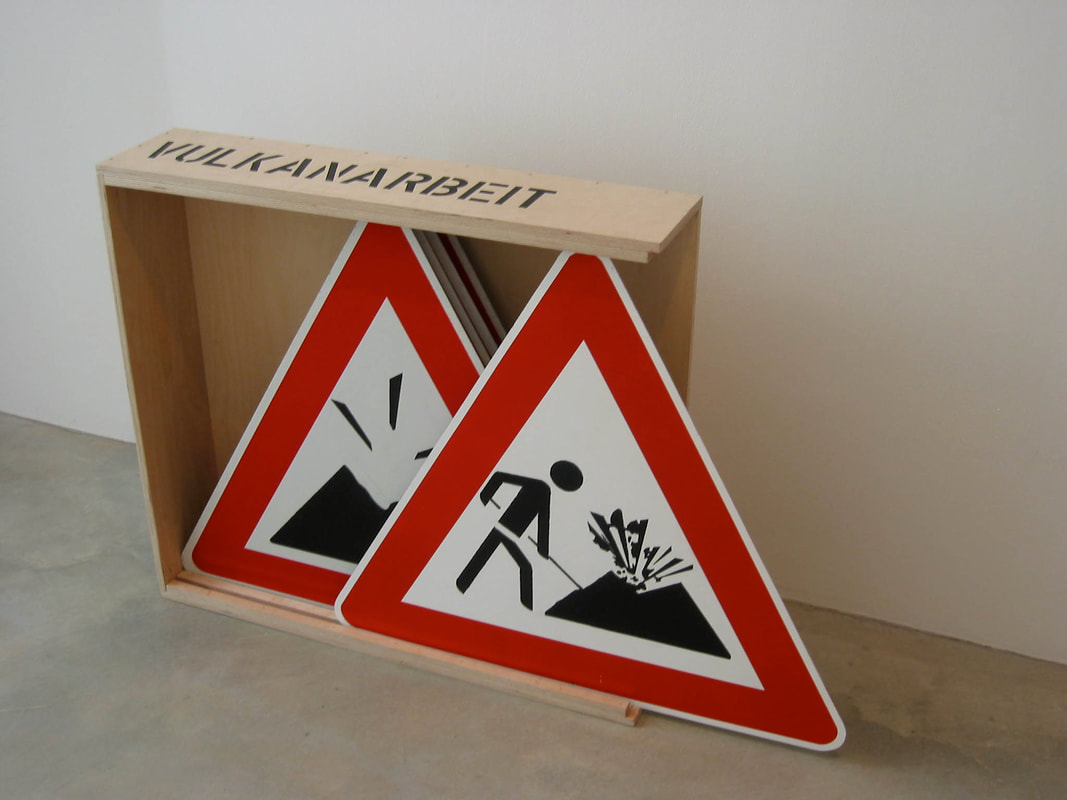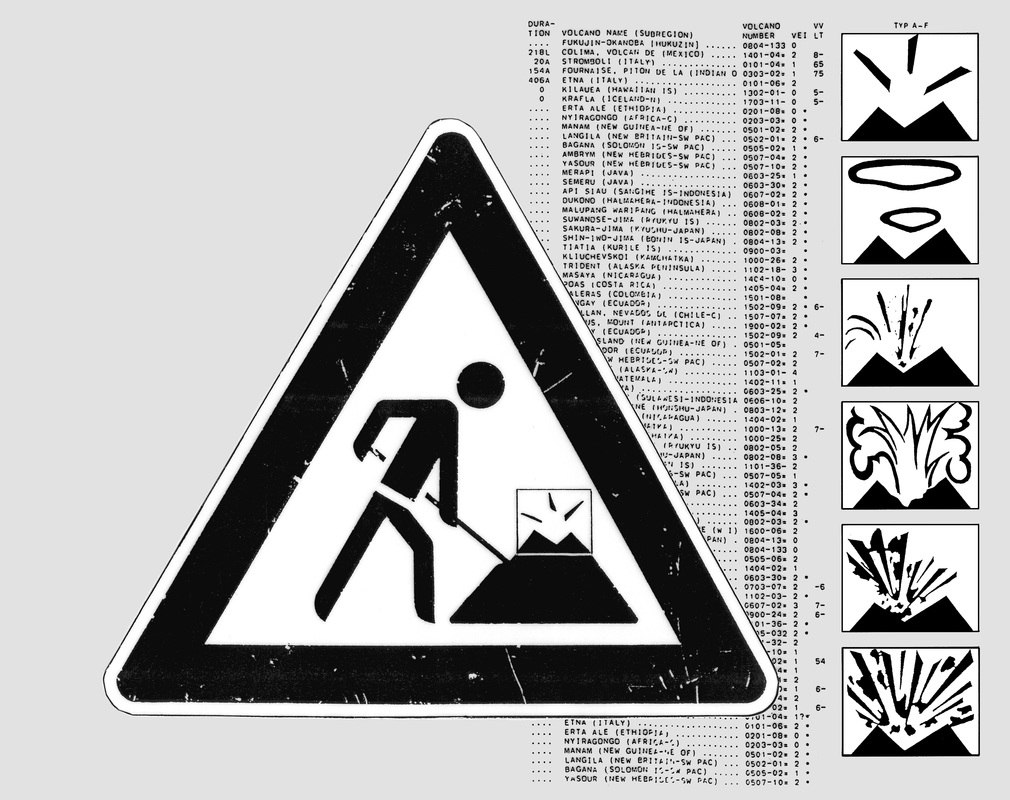Vulkanisches Feld/ Volcanic Field, Gleisdreieck, Gelände der Bodenlosistik Süd/ Site of the ground logistic center, Berlin (DE), 1996, Simulation einer vulkanischen Eruption mit pyrotechnischen Rauchwolken / simulation of a volcanic eruption by clouds of pyrotechnic smoke-signs. Edition of 3, digital print on canvas, 140 cm x 80 cm.
|
Die Baustellen der Stadt werden als zivilisatorische Orte des Umbruchs mit umwälzenden Naturereignissen verglichen. Die „Vulkane“ werden dabei zu Erdskulpturen erklärt, während der kraterartige Aushub und die kegelförmige Aufhäufung durch Baumaschinen in den Zeichnungen und Fotografien als „Earthworks“ in Erscheinung treten.
|
As places of upheaval within a civilization, the city’s construction sites are compared with transformational natural events. The “volcanoes” are declared to be earth sculptures, while the crater-like excavation and the conical piles created by construction vehicles appear in the drawings and photographs as “earthworks.”
|
Die Baustellen der Stadt werden als zivilisatorische Orte
des Umbruchs mit umwälzenden Naturereignissen verglichen. Die „Vulkane“ werden dabei zu Erdskulpturen erklärt, wäh rend der kraterartige Aushub und die kegelförmige Aufhäu- fung durch Baumaschinen in den Zeichnungen und Fotogra- fien als „Earthworks“* in Erscheinung treten. Die Bezeich- nung „earth art works“ hatte Robert Smithson im Zusammen- hang mit Industrielandschaften gebraucht. Als Betrachter der prozessualen Kunsterfahrung werden die Vulkanarbeiter aktiv integriert und so selbst zu Akteuren. Auf den Bauschil- dern werden die Baustellen als „Vulkane“ und „Neuland“ mit einem Aufkleber gekennzeichnet. Auf diese Weise wird das Konzept des Vulkans individuell und kollektiv festgeschrie- ben. Die Karte mit weltweit 5000 aktiven Vulkanen kann innerhalb von zehn Jahren (ab 1993) durch 5000 Baustellen ergänzt werden, die seit 1993 entstanden sind.
* Werkner, Patrick (1992), S. / p. 47 ff. „Ein Begriff, der ursprünglich aus der Militärsprache kommt und in den sechziger Jahren Erdarbeiten als konzeptionelle Objets Trouvés definiert.“ / “A term originally used by the military, in the 1960s earthworks were defined as conceptual objets trouvés.”
As places of upheaval within a civilization, the city’s construction sites are compared with transformational natural events. The “volcanoes” are declared to be earth sculptures, while the crater-like excavation and the conical piles created by construction vehicles appear in the drawings and photographs as “earth- works.”12 Robert Smithson used the term “earth art works” in connection with industrial landscapes. As observers of the processual art experience, those work- ing on the volcano are actively integrated and thus become actors themselves.
On the construction signs, the construction sites are marked with a sticker as “volcanoes” and “uncharted territory,” thereby establishing the concept of the volcano both individually and collectively. In the decade following 1993, it was possible to supplement the map of 5000 active volcanoes worldwide with an additional 5000 construction sites that had been set up since that point.
des Umbruchs mit umwälzenden Naturereignissen verglichen. Die „Vulkane“ werden dabei zu Erdskulpturen erklärt, wäh rend der kraterartige Aushub und die kegelförmige Aufhäu- fung durch Baumaschinen in den Zeichnungen und Fotogra- fien als „Earthworks“* in Erscheinung treten. Die Bezeich- nung „earth art works“ hatte Robert Smithson im Zusammen- hang mit Industrielandschaften gebraucht. Als Betrachter der prozessualen Kunsterfahrung werden die Vulkanarbeiter aktiv integriert und so selbst zu Akteuren. Auf den Bauschil- dern werden die Baustellen als „Vulkane“ und „Neuland“ mit einem Aufkleber gekennzeichnet. Auf diese Weise wird das Konzept des Vulkans individuell und kollektiv festgeschrie- ben. Die Karte mit weltweit 5000 aktiven Vulkanen kann innerhalb von zehn Jahren (ab 1993) durch 5000 Baustellen ergänzt werden, die seit 1993 entstanden sind.
* Werkner, Patrick (1992), S. / p. 47 ff. „Ein Begriff, der ursprünglich aus der Militärsprache kommt und in den sechziger Jahren Erdarbeiten als konzeptionelle Objets Trouvés definiert.“ / “A term originally used by the military, in the 1960s earthworks were defined as conceptual objets trouvés.”
As places of upheaval within a civilization, the city’s construction sites are compared with transformational natural events. The “volcanoes” are declared to be earth sculptures, while the crater-like excavation and the conical piles created by construction vehicles appear in the drawings and photographs as “earth- works.”12 Robert Smithson used the term “earth art works” in connection with industrial landscapes. As observers of the processual art experience, those work- ing on the volcano are actively integrated and thus become actors themselves.
On the construction signs, the construction sites are marked with a sticker as “volcanoes” and “uncharted territory,” thereby establishing the concept of the volcano both individually and collectively. In the decade following 1993, it was possible to supplement the map of 5000 active volcanoes worldwide with an additional 5000 construction sites that had been set up since that point.
Schilder: a) Ständige Vulkangefahr b) Schlafender Vulkan c) Aufbrechender Vulkan d) Feuerspeiender Vulkan e) Explosiver Vulkan
Signs: a) Constant danger from volcanoes b) Dormant volcano c) Erupting volcano d) Fire-spewing volcano e) Explosive volcano
Signs: a) Constant danger from volcanoes b) Dormant volcano c) Erupting volcano d) Fire-spewing volcano e) Explosive volcano





